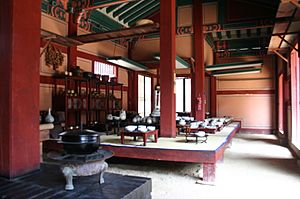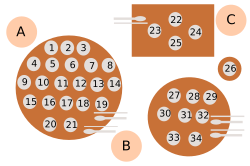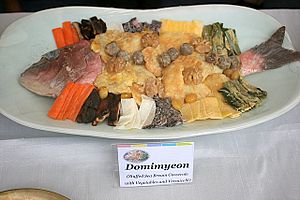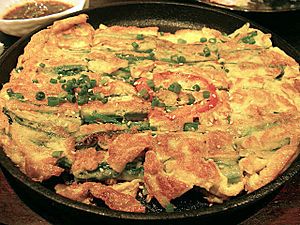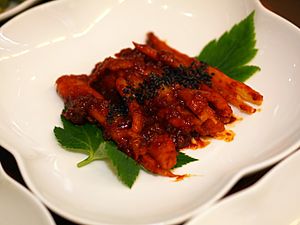Korean royal court cuisine facts for kids
| Korean royal court cuisine | |
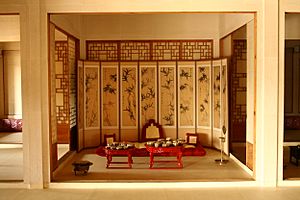 |
|
Quick facts for kids Korean name |
|
|---|---|
| Hangul |
조선왕조 궁중요리
|
| Hanja | |
| Revised Romanization | Joseon Wangjo Gungjung yori |
| McCune–Reischauer | Chosŏn Wangjo Kungjung yori |
Korean royal court cuisine (Joseon Wangjo Gungjung yori) is the special cooking style that was eaten by the kings and queens of the Joseon Dynasty in Korea. This dynasty ruled Korea from 1392 to 1910. Today, people are trying to bring back this amazing cooking style.
It is said that a royal meal should have twelve different dishes, served along with rice and soup. Most of these dishes were served in special bronze bowls called bangjja.
Contents
History of Royal Korean Food
In the past, the food served in the royal palace was called gungjung eumsik. It showed how rich and powerful the rulers of Korea were. For example, during the Silla kingdom, there was a man-made lake called Anapji Lake in Gyeongju. It had many buildings just for fancy parties! There was even a special water channel, Poseokjeong, where wine cups floated during poetry writing.
Korean royal food took ideas from different regions and nearby countries. This made it a showcase of the best foods. The royal family received the finest foods from all over the country. Even though there are old records of royal parties before the Joseon period, they often just listed many foods without saying exactly what they were.
Unlike regular people's meals, royal meals changed a lot every day. They were not just based on the season. Each month, governors from Korea's eight provinces sent special ingredients to the palace. This gave the royal cooks a huge variety of foods to use.
Food was very important during the Joseon period. Special jobs were created in the government's Six Ministries (Yukjo). These jobs were all about getting and preparing food and drinks for the royal family. For example, the Board of Personnel (Ijo) had people whose job was to get rice for the king. The Board of Rites (Yejo) handled food for special ceremonies, wines, and even medicinal foods.
Hundreds of people worked in the palace kitchens. Many were women from common or lower-class families. They were the main cooks for the royal family. These women were divided into different groups based on their skills. For example, there was a "Bureau of special foods" (Saenggwa-bang) and a "Bureau of cooking foods" (Soju-bang). Sometimes, male cooks from outside the palace helped during very large parties.
During the Joseon period, the royal palace usually served five meals a day. This pattern had been around for a long time. Three of these meals were full meals, while the other two were lighter snacks.
- The first meal, mieumsang (미음상), was served at sunrise. It was a rice porridge (juk, 죽) made with ingredients like abalone (jeonbokjuk), white rice (huinjuk), mushrooms (beoseotjuk), pine nuts (jatjuk), or sesame (kkaejuk). Side dishes included kimchi, nabak kimchi, oysters, and soy sauce. This porridge was believed to give the king and queen energy for the day.
- The sura (수라) were the main meals. Breakfast was served around ten in the morning, and dinner was served between six and seven in the evening. A surasang (수라상) meal usually had three tables. It included two types of rice, two types of soup, two types of stew (jjigae), one meat stew (jjim), one casserole (jeongol), three types of kimchi, three types of sauces (jang), and twelve side dishes (called 12 cheop).
The meals were set up in a special room called the suragan (수라간). The king sat to the east and the queen to the west. Each had their own tables. Three palace servant women, called sura sanggung (수라상궁), helped them. These women would uncover the dishes and offer the food after making sure it was safe to eat.
Today, this special Korean food heritage is recognized by the government as an Important Intangible Cultural Property No. 38. Han Bongnyeo is currently known as the Living National Treasure for keeping this cooking tradition alive.
Surasang Setting
The surasang meal was served on three tables and included a hotpot.
- The largest round table on the left was the main table. It held the main rice bowl, soups, stews, and many side dishes.
- The smaller round table at the bottom right held special red rice, a thick meat broth (gomtang), dessert, tea, and empty dishes. This table was also used to hold the covers from the main dishes.
- The rectangular table at the top right had eggs, sesame oil, fresh vegetables, and different sauces.
- A hotpot, usually with a casserole like sinseollo, was heated with charcoal in the middle right.
Main Dishes Served in a Bowl
Sura (Rice Dishes)
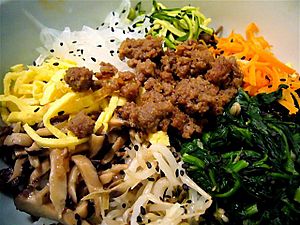
Sura (수라) is a bowl of boiled rice and grains. Two kinds of sura were always served:
- White Sura (흰수라): Plain boiled rice.
- Red Sura (홍반): Rice boiled with water from azuki beans, giving it a reddish color.
- Five Grain Sura (오곡수라): Made by boiling rice, sweet rice, glutinous millet, and azuki beans together.
- Goldongban (골동반): This is what we call bibimbap today. It's boiled rice mixed with steamed vegetables, roasted beef, and a fried egg.
Juk, Mieum, and Eungi (Porridges)
Juk (죽) and mieum (미음) or eung-i (응이) are types of rice porridge usually served in the morning. Juk is thicker, while mieum is thinner, like a gruel.
- Omija eungi (오미자응이): Made from boiled omija berries with honey, then thickened with mung bean starch.
- Sok mieum (속미음): Sweet rice, red jujubes, ginseng root, and chestnuts simmered together.
- Jatjuk: Rice soaked and pine nuts ground, then boiled in water.
- Heukimjajuk (흑임자죽): Black sesame seeds ground and boiled with rice.
- Tarakjuk (타락죽): Soaked rice boiled with water, then cow's milk is added and boiled more.
Guksu (Noodles)
Guksu (국수) are noodles made from buckwheat or wheat flour. Buckwheat was often preferred.
- Myeon sinseollo (면신선로): Boiled beef shank, scallops, Korean parsley, and bamboo sprouts boiled in beef broth. Boiled noodles are then added.
- Onmyeon (온면): Beef broth is added to roasted beef, sliced egg pancake, and noodles.
- Domimyeon (도미면): A noodle soup made with panfish, sliced egg pancakes, ginkgo seeds, walnuts, fried meatballs, and pine nuts.
Mandu and Tteokguk (Dumplings and Rice Cake Soup)
Mandu (만두) are boiled or steamed dumplings. The dough is made from wheat or buckwheat flour and filled with various ingredients. Tteokguk (떡국) is a soup made with sliced tteok (glutinous rice cakes).
- Jangguk mandu (장국만두): Filled with kimchi, pork, and tofu.
- Saengchi mandu (생치만두): Made with pheasant, dropwort, cabbage, and shiitake mushrooms. Buckwheat dough is used, and the dumplings are boiled in meat broth.
- Tteokguk (떡국): Round slices of tteok (like coins) are boiled in meat broth. It's served with egg pancake slices and roasted ground meat.
- Eo mandu (어만두): Dumplings made with thin slices of fish flesh as the wrapper, filled with minced beef, vegetables, and spices.
Other Main Dishes
Tang (Soups)
Tang is a type of soup often made with beef shank, intestines, bones, and beef brisket.
- Malgeun guk (맑은 국): A hot and clear soup, like clear beef soup or dried pollock soup.
- Gomguk: A thick soup made by simmering ingredients for a long time. Examples include gomtang (곰탕) and seolleongtang (설렁탕).
- Naengguk: A soup served cold, like cucumber cold soup.
Jochi and Gamjeong (Stews)
Jochi (조치) and gamjeong (감정) are stew-like dishes, similar to what is called jjigae today. If they are seasoned with gochujang (chili paste), they are called gamjeong. Jochi is seasoned with salt or salted shrimp.
- Crab gamjeong
- Oyster jochi
- Fish jochi
Jjim and Seon (Steamed Dishes)
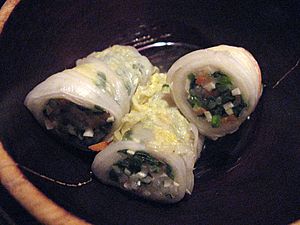
Jjim (찜): Steamed or boiled beef, pork, or fish seasoned with vegetables. Seon (선): Steamed vegetables, tofu, or fish stuffed with fillings made from beef or chicken and onions.
- Ox tail jjim
- Dubuseon (두부선): Steamed tofu with fillings.
- Oiseon (오이선): Made with cucumber.
- Baechuseon (배추선): Made with napa cabbage.
Jeongol and Sinseollo (Casseroles)=
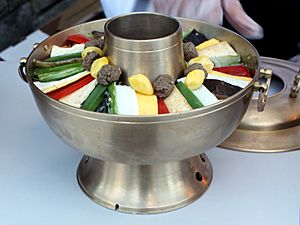
Jeongol and sinseollo are similar to Western stews or Chinese hotpots. Sinseollo (a type of jeongol) is boiled in meat broth with various vegetables and mushrooms in a special pot with holes. Both jeongol and sinseollo are served with a small burner to keep them hot.
- Domi guksu jeongol: Made with noodles and Red seabream.
- Dubu jeongol: Made with tofu.
Side Dishes
Saengchae (Fresh Salads)
Saengchae (생채) is like a salad seasoned with salt, vinegar, soy sauce, or mustard sauce.
- Mu saengchae: Made of shredded radish.
- Oi saengchae: Made of cucumber.
Namul (Seasoned Vegetables)
Namul (나물) are various steamed vegetables seasoned with hot pepper, garlic, green onion, salt, and sesame or perilla oil. Common vegetables include spinach, radish, bracken, zucchini, and Korean bellflower. Sometimes, potato starch noodles (dangmyeon) and roasted beef are also used.
Jorigae (Hard-boiled Dishes)
Jorigae (조리개) are foods that are hard-boiled with strong seasonings. Meats, fish, and vegetables are mainly used.
- Beef jorigae
- Small yellow croaker jorigae
Jeonyuhwa (Pancakes)
Jeonyuhwa (전유화) or jeon is a dish that looks like a pancake. Main ingredients are lightly coated with egg and wheat flour. Eggs, flour, and other ingredients can also be mixed to make pancakes.
- Saeu jeon: Made with shrimp.
- Bindaetteok: Made from ground mung beans and other ingredients.
- Pajeon: Made with green onions.
Gui (Grilled Dishes)
Gui is a general Korean term for roasted and seasoned dishes. The main ingredients can be seaweed, beef, deodeok root (a type of bonnet bellflower), fish, mushrooms, or vegetables.
- Garibi gui or gari gui: An old term for galbi, which are grilled short ribs seasoned with soy sauce.
- Neobiani: An older form of bulgogi.
- Dak sanjeok: Grilled chicken and vegetables on skewers.
Hoe (Raw Dishes)
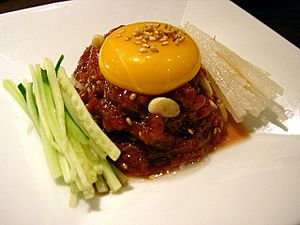
Hoe (회) is raw fish or raw seasoned beef.
- Yukhoe: Raw seasoned beef.
Jang (Sauces)
These are important sauces used in Korean cooking:
- Doenjang: A soybean paste, similar to miso, but often with whole or partly crushed beans. It's fermented in special crocks.
- Gochujang: A hot pepper soybean paste sauce.
- Chogochujang (초고추장): Chili paste mixed with vinegar.
Banchan (Small Side Dishes)
These are various small dishes served with the main meal:
- Pyeonyuk (편육): Steamed meat.
- Sukchae (숙채): Steamed vegetables.
- Jorim: Meat, fish, and vegetables lightly boiled with seasoning.
- Jeotgal: Fermented salty fish.
Dessert
- Tteok (rice cake): These are mostly made of rice and are eaten as a dessert or during holidays like Chuseok (Korean Thanksgiving). They can have sweet red bean or sesame fillings. Tteok are usually mildly sweet and enjoyed by everyone.
Tea and Fruit Punch
- Sikhye: A sweet rice punch. You can find many kinds of canned sikhye today.
- Sujeonggwa: A sweet drink flavored with ginger and cinnamon. Dried persimmons and pine nuts are added when served.
- Fruit Hwachae: A fruit punch made by mixing different fruits, or sometimes just one fruit like cherries, strawberries, peaches, or watermelons. Some hwachae have floating azalea petals or slices of pear in omija-flavored water, sweetened with honey or sugar.
See also
 In Spanish: Gastronomía de la corte real coreana para niños
In Spanish: Gastronomía de la corte real coreana para niños


